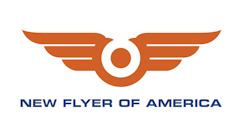Tighter budgets, congestion, no room for more parking, pressures to be more green, universities are facing a lot of challenge — and public transportation systems are helping universities meet those challenges.
At the American Public Transportation Association’s Public Transportation & Universities Conference, university professionals, planners and transit professionals came together to share best practices and to discuss the unique demands of serving the university communities.
The conference was held in Grand Rapids, Michigan, hosted by The Rapid and Grand Valley State University, an example of how collaboration between a transit system, a university and local government can lead to exponential benefits to the communities they serve.
The Rapid Chief Executive Officer Peter Varga and External Relations Manager Jennifer Kalczuk provided the transit agency perspective, GVSU Vice President for Finance and Administration James Bachmeier and Assistant Vice President, Pew Campus & Regional Centers, Lisa Haynes offered the university perspective and former Grand Rapids Mayor George Heartwell spoke on the perspective of the local government.
Read more on the evolution of that partnership and where it’s headed at masstransitmag.com/12195804
Sustaining Campus Populations
If campuses want to embrace sustainability, they have to look at how people are getting there. There’s only so many parking lots they can build.
Being a campus out in the middle of cornfields, GVSU had to look for a sustainable option for get students, faculty and staff to and from campus.
"You can come to this university and not have a car because we have a great system," Varga said in regard to GVSU. "Our contract with the university is not complicated; we focus on what we've done and what we will do."
In Austin, Texas, the University of Texas at Austin faced a different challenge. Blanca Gamez, assistant director | administration/alternative transportation, the University of Texas at Austin, explained they were a landlocked university with nowhere to grow but up. They have 51,000 students, about 75,000 people coming to the university every day and 16,000 parking spaces.
The original shuttle system was started by a fraternity in 1957, but today it has grown into a 50/50 partnership with a dedicated shuttle fleet. Of Capital Metropolitan Transportation Authority’s 81 routes, Annie Arguello, program manager — university services, Cap Metro, said 12 are UT’s.
To help Virginia Tech move people more safely and efficiently, the university, town and Blacksburg Transit are working together to build the Blacksburg Transit Multi-Modal Transit Facility on campus. Not only becoming the central part of campus, this $30 million facility will displace a lot of parking.
Ron Reekes, project manager, and Philip Muse, associate principal, both with Wendel, also explained a unique component of the project, in that it is going to be a LEED Platinum project that will serve as a living classroom to teach about sustainable technologies.
The Funding Puzzle
Always the top of any discussion, funding was a reoccurring theme throughout all of the sessions. StarMetro Transit Planning Manager Brian Waterman shared pros and cons of various campus payment models.
With the per hour cost model, it’s guaranteed money. The challenge is that universities want to pay for only service they want, not for the rest of the system, it requires annual negotiations and the university has all of the control.
The per-trip model, such as a pay-per-swipe with a U-pass type program, it is an easy-to-implement payment model. The funding supplements existing service to provide a system-wide benefit. This model isn’t very efficient as it requires billing and there can be conflicts between the transit agency and the university over how data is collected.
An assessed fee added to a student fee is simple to calculate and simple to negotiate. The fee is paid directly to the transportation system and the control of service lies with the transit agency. A challenge is that the fee is tied to enrollment and it could lead to less money if the transportation system fee is lowered.
Targeted Campaigns
To integrate the benefits of public transportation to university students — successful marketing campaigns can develop a generation of good transit users. In turn cutting down on unnecessary congestion caused in traffic and parking lots.
“Useful information and fun gives your campaign depth and encourages millennials to come back,” said Lolo Robison, director of marketing for Capital Area Transportation Authority (CATA).
CATA set forth developing campaigns that could engage users over social media. One example is their “Where’s CATA Man” campaign, they show a cutout of CATA Man with just a background — located somewhere around the campus. The campaign allowed riders to interact with CATA and increased engagement over social media.
Brittany Schlacter, outreach coordinator for digital media for The Rapid found that responding to riders comments — negative and positive — was an effective tool for problem solving and showing appreciation for riders. Schlacter said that while having social media is essential, if agencies are not interacting with their riders, social media accounts are not fully being utilized.
Encouraging university students to get involved through social media opens a conversation to discover what issues they have with public transportation, and what they feel could be done to make their transportation experience more positive.
More information on marketing and communicating with universities at:
http://www.masstransitmag.com/12196060
Integrating Technology
Technology is being utilized to help agencies be more efficient in moving students. Mobile payments and real-time information provide an easy-to-use system for students, faculty and staff and streamline service to save agencies money.
There were a lot of discussions about electric buses and two of the reoccurring themes were learn about charging so you understand infrastructure requirements and utility costs and standardization. Bus OEMs have been working together to develop standards so there can be interoperability between the various vehicles and charging infrastructure.
There were also conversations about benefits to fuel cell technology, as auto manufacturers, such as Honda, Toyota and Hyundai, are making the technology more mainstream.
While the typical electric bus range is about 120 miles, a fuel cell bus is more than twice that. David Warren, director of sustainable transportation, New Flyer of America Inc., said the hydrogen fuel cell electric buses have the benefits of a battery-electric bus, but offers the advantage of the extra range you can store in the hydrogen tanks. As he explained, “The bus thinks it’s an electric bus.”
More on the products and technologies on display at the conference at masstransitmag.com/12196361
To highlight some of the latest in sustainable technologies, there was a technical tour of The Rapid’s Central Station and The Wealthy Street Operations Center. The Central Station was America’s first LEED-certified public transportation facility, and The Wealthy Street Operations Center, a LEED Gold-certified facility. More information on those facilities at masstransitmag.com/11588784
Safe Systems
For the millennial generation that grew up with technology an already prevalent factor in their daily lives, safe transit needs to continue to evolve to fit that. Brandon Leslie, General Manager, “T Campus” Transit at University of Tennessee, said that they designed their late-night safe ride to form a link to students who live off campus.
Leslie says that what they were hearing from their students was that they wanted an ‘on-demand’ option — a service that picked them up from wherever they were at. As a result Leslie says they incorporated an app where students could request a safe ride from their mobile phone and not need to wait outside in the dark. It provided an increased awareness in the student population and students felt more secure with decreased wait times.
Mobile safe ride services can have dispatchers monitoring activity from a dashboard — while university students are able to track where their ride is and when it will arrive. Safety is a prevalent issue on campuses and can serve as a selling point for the expansion of transit services.
Collaborative Learning
While Varga opened the conference talking about the collaborative environment that has led to a transformation in Grand Rapids, that theme was echoed throughout the conference.
Varga stressed that the conference was a way for agencies to learn from each other on what works when implementing university transit routes and how to overcome challenges.
“What bothers a large transit agency might not effect a smaller one, but you can still get advice on what to do,” Varga said.
Andrew Johnson, general manager at Connect Transit, said a partnership between transit and universities can have an exponential impact in a community and Heartwell stressed, “If your university and city isn’t working together, there is probably a mayor that needs to wake up because it’s a powerful tool to be able to use.”





